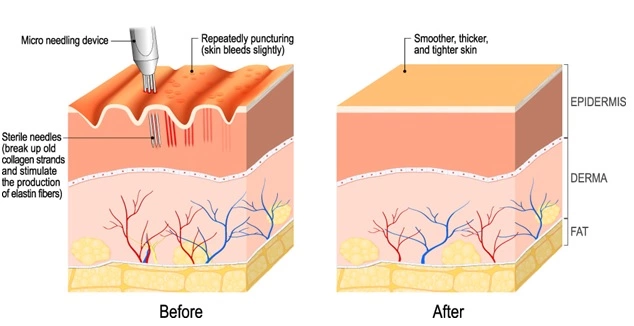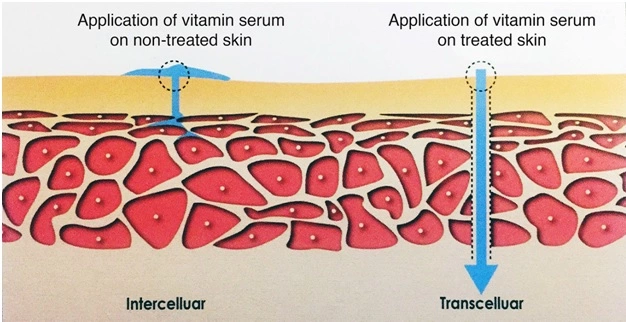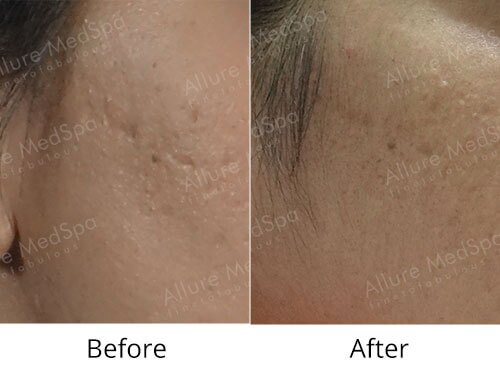Dermaroller Treatment for Scars and Stretch Marks in Andheri West, Mumbai, India
Skin problems affect all of us in one way or another. Your skin plays an important role in building self-confidence and self-esteem. Having pigmented, uneven and damaged skin can be worrisome. Dermaroller is one such solution to all your skin problems. What’s great about the derma roller is that with a little guidance you can really work on your skin problems at home without the fear of air pollution, dirt, and debris from your daily commute, triggering breakouts.
For anyone who’s looking for a way to tackle these concerns at home, micro-needling or derma rolling might be your answer. Here’s what you need to know about this miraculous process.
What is derma rolling?
A derma roller is a skincare device used to help rejuvenate the skin, treat acne scarring, pigmentation and reduce the signs of aging. Derma rolling or micro-needling involves rolling miniature needles up, down, and across your face via a rolling or stamping device to promote healing and new skin growth.
Derma rolling works by inducing collagen and elastin formation by causing small wounds. This protein is also responsible for your youthful appearance.
Despite its appearance, derma rolling is a minimally invasive procedure with little to no downtime. The length of the needles used, however, has a significant impact on the healing process. Obviously, the longer the needles, the longer the time it takes to heal.
Also Check
Rating: 4.8
Reviews: 369
Rating: 4.8
Reviews: 100
If you are wondering which treatment works best for your skin problems, a dermatologist can assist you in making that decision as their in-depth medical knowledge could help in determine which procedure would give promising results. With all procedures, side effects are possible. In the skilled hands of a board-certified dermatologist, side effects tend to be minor and temporary.
Dr. Shweta is one of the most renowned names in cosmetic treatment in Mumbai served thousands & thousands of patients happily, including Bollywood celebrities and many patients from out of the country. Treating various skin conditions requires a deep medical knowledge and years of experience as these lesions are look similar to lots of other conditions. Dr. Shweta’s credentials are your best option for getting a correct diagnosis followed by a customized treatment plan.
As you have read, there are lots of options for the treatment of various skin conditions. Different faces need different set of options and only a well-seasoned doctor could identify what set of treatment could work for you. She has expertise in solving the issue of skin, that needs cosmetic attention. She has extensive experience and expertise in performing cosmetic procedures like laser therapy, chemical peels, microdermabrasion, CO2 laser and many more with delivering optimum results with 110% patient satisfaction every single time.
The cost of derma rolling depends on the type and severity of the skin condition you have. It can be Rs.1500 to Rs. 4000 per session depending on what is being treated. The procedure usually requires 3-6 sessions based on your skin’s needs.
Allure Medspa which is renowned for its state-of-the-art internationally acclaimed services offer affordable and cost-effective cosmetic procedures. To know more about the cost of your procedure requests a consult by filling out the form below. Your consultation is your chance to ask questions about skin peeling treatments and put your mind at rest. Our surgeons and cosmetologists will be there to offer full explanations and answers to all of your queries.
Alternatively, our Counsellor will call you at a convenient time. Request a consultation right aways.
While derma rollers at home might have a visible effect, you won’t see as big of a difference as you would with a professional micro-needling session. Before proceeding, consult your dermatologist if you have any concerns or questions.
Your dermatologist can assist you in determining the cause of your skin problem and can help also is assessing if derma rolling is right for you or not. Your dermatologist can then develop a treatment plan that is right for you. That one visit could make a significant difference in your quality of life for years to come.
If you and your dermatologist agree that procedure is the best choice for you, your dermatologist will devise a tailor made treatment plan exclusively for you. Your dermatologist will consider a variety of factors when developing this plan, including your main cause of skin problem, location, severity, etc. If you have taken any kind of previous skin related treatment, be sure to tell your dermatologist about that before the treatment begins.
Because derma rolling is a minimally invasive process, you’re unlikely to have any negative side effects if you utilise the proper technique and serum. However, if you’re not careful, it could result in permanent scarring and skin discoloration.
Some people should absolutely avoid derma rolling. Those with eczema, psoriasis, or a history of blood clots are at risk.
Before doing it yourself, check with your dermatologist if you have skin disorders that could readily spread to other parts of the face, such as active acne or warts. In such cases, begin only after having a professional consultation.
You should also be cautious if you’re using retinol, or have sunburn. To avoid any side effects, experts recommend quitting retinol 5 days before derma rolling. You can still use a derma roller to treat sunburn or irritation as long as you avoid the affected areas.
People can experience a significant improvement in acne scarring or wrinkles in as little as two to three sessions utilising 1.5 mm monotherapy, according to well-documented studies. Of course, regular use yields superior outcomes. However, the researchers discovered that the effects of three sessions linger for six months following the last treatment.
This demonstrates what three 1.5 mm sessions of incremental development may achieve. Remember, if you do try derma rolling, never use it on active skin conditions like acne.
Stainless steel or titanium needles are used in derma rollers. However, for all intents and purposes, both types will accomplish the same task. Because titanium is a stronger alloy than stainless steel, it is more durable. This means that the needles will last longer and will not blunt as rapidly.
Stainless steel, on the other hand, is more sterile by nature. It’s also sharper and blunts faster. Medical professionals like stainless steel better to use.
Derma rollers, use smaller needles which causes minor trauma to the skin’s outer layer. This form tiny paths in the skin. This activates the skin’s healing response, resulting in skin regeneration and the production of anti-aging proteins like collagen and elastin.
Serums can exploit these channels to penetrate deeper into the body, absorbing more efficiently and creating more noticeable effects.

The skin may:
- be red for a few hours, sometimes less,
- feel like a sunburn
- swell at first after rolling (very minor)
- Feel as if your face is pulsing and blood is circulating in your veins.
People frequently mistake mild swelling for overnight success, but the plumping effect you perceive at first will fade within a few days. However, as previously said, frequent rolling has long-term consequences!
For the next two or three days, there will be some moderate erythema (redness), and the skin may begin to peel. If this happens, don’t pick at it! With time, the peeling will fall off spontaneously.
Use products that focus on moisturising, mending, and promoting collagen production to take your results to the next level. Using a sheet mask after rolling is the single best thing you can do.
Collagen induction, anti-aging, even skin tone, and barrier function are all benefits of this product.
Sheet masks aren’t your thing? Look for:
- vitamin C serums or products (either ascorbic acid or sodium ascorbyl phosphate)
- hyaluronic acid
- niacinamide
- epidermal growth factors (HA)

The length of needles you’ll be using determines how often you derma roll. The maximum number of times you can use a derma roller in a specific time frame is listed below:
| Needle length (millimeters) | How often |
| 0.25 mm | every other day |
| 0.5 mm | 1 to 3 times a week (starting with less) |
| 1.0 mm | every 10 to 14 days |
| 1.5 mm | once every 3 to 4 weeks |
| 2.0 mm | every 6 weeks (avoid this length for home use) |
Before beginning another session, make sure your skin has fully recovered. Collagen regrowth is a lengthy process. It’s important to remember that the skin takes a long time to regenerate.
To avoid any dangers or illnesses, carefully follow these measures.
Step 1: Clean your roller.
Allow your derma roller to soak in 70% isopropyl alcohol for about 5-10 minutes to disinfect it.
Step 2: Take a shower and wash your face.
Before beginning the rolling procedure, thoroughly cleanse your face with a moderate pH-balanced cleanser.
Step 3: If necessary, apply numbing cream.
You may need to use an anaesthetic cream depending on your pain tolerance. If you use numbing cream, make sure to follow the manufacturer’s recommendations and wipe it off completely before you begin rolling.
Step 4: Begin derma rolling
The technique is very important while using derma roller. To make the process easier, you can spilt your face into sections also. While derma roller is very versatile, avoid rolling it around your eyes (eye socket area).
- Roll 6 to 8 times in one direction, depending on your skin tolerance and sensitivity, then lift the roller after each pass to avoid the unpleasant track markings.
- Roll in the same spot 6–8 times, then slightly adjust the derma roller and continue. Carry on like this until you’ve covered the entire area of skin you’re working on.
- After rolling in one direction, go back over the area you previously rolled in the opposite direction and repeat the process. For example, if you just finished rolling across your forehead vertically, now is the time to go back and do it again horizontally.
- You should have rolled over each area 12 to 16 times by the end of the procedure — 6 to 8 horizontally, 6 to 8 vertically.
We do not need to roll diagonally, contrary to popular assumption. As a result, the pattern distribution is unequal, with more stress in the centre. If you decide to go ahead with it, please be cautious and take extra precautions.
Step 5: Wash your face with water again
After you’re done micro-needling, rinse your face with water only.
Step 6: Clean your derma roller
Dishwasher soap can be used to clean your derma roller. In a plastic container, make a soapy water mix and rapidly swish it around the roller, making sure it doesn’t strike the sides. Because alcohol does not dissolve the proteins found in skin and blood, we use detergents like dish soap right after rolling.
Step 7: Disinfect your roller
Allow your derma roller to soak for 10 minutes to disinfect it once again. Replace it in its case, kiss it, and keep it somewhere secure.
Step 8: Continue your basic skincare routine
Apply a basic skincare routine after derma rolling.
This will mostly be determined by the goal you’re attempting to achieve. Because we’re all about keeping things simple, here’s a table detailing the lengths that should be used depending on the problem you’re trying to solve.
| Concerns | Needle length (millimeters) |
| Shallow acne scars | 1.0 mm |
| Deep acne scars | 1.5 mm |
| Enlarged pores | 0.25 to 0.5 mm |
| Post-inflammatory-hyperpigmentation (blemishes) | 0.25 to 0.5 mm |
| Skin discoloration | 0.2 to 1.0 mm (start with the smallest) |
| Sun-damaged or sagging skin | 0.5 to 1.5 mm (a combination of both is ideal) |
| Stretch marks | 1.5 to 2.0 mm (avoid 2.0 mm for home use) |
| Surgical scars | 1.5 mm |
| Uneven skin tone or texture | 0.5 mm |
| Wrinkles | 0.5 to 1.5 mm |
Note: Microneedling will not help with redness or pink blemishes that occur after an inflammatory reaction. Also, derma rollers or micro-needling equipment with a length of more than 0.3 mm are not permitted.

We at Allure Medspa in India, have world-class facilities in place to cater to your every need when it comes to cosmetic treatment. Here we have dedicated to the best results. If you have decided upon undergoing stretch mark treatment, here we have a wide range of procedures including surgical treatments for stretch marks under one roof to cater to all your needs.
To learn more about stretch marks treatment and find out if it’s right for you, call our clinic: +91-9869041559
Today, we are here with virtual consultation even in this quarantine:
Q: What is derma rolling good for?
A: Dermarolling tightens the skin and can help with acne scarring, pore reduction, and wrinkle and fine line reduction. It also improves the absorption of products such as serums into the skin. To avoid side effects, make sure to clean, disinfect, and use the gadget properly.
Q: Is derma rolling safe?
A: With adequate training, the derma roller (a handheld micro-needling device with hundreds of tiny needles that puncture holes into the face to make skin look younger) is safe to use at home. The safest approach to use it is to visit a dermatologist.
Q: Do dermatologist recommend derma roller?
A: Yes, derma roller when used by a professional dermatologist in a session is very effective in treating various skin conditions. Micro needing stimulates collagen production which improves the texture and the look of your skin.
Q: How do you sanatize a derma roller?
A: Allow your derma roller to soak in 70 percent isopropyl alcohol for 5 to 10 minutes to disinfect it.
Q: What are the side effects of derma roller?
A: Micro-needling, like all cosmetic procedures, carries some risk. Minor skin irritation is the most common side effect right after the treatment. For a few days, you may see redness.
Q: What should I put on my face after derma rolling?
A: Wash your face with a mild cleanser after derma rolling. Apply a good serum and wait for some time to get it absorbed completely. Apply light moisturizer throughout the day, if needed.
Q: Is derma rolling painful?
A: The needles on at-home derma rollers are short, so they don’t pierce the skin deeply enough to cause pain. However, anything deeper than 1.5mm might be uncomfortable, thus dermatologists will usually apply a numbing cream to your face an hour before your appointment.
Q: Can you derma roll every day?
A: It is generally not recommended because the skin does not have enough time to heal. Derma rollers with a diameter of 0.5mm or longer should never be used on a daily basis. Using a derma roller of any size on a daily basis can cause extremely dry skin.
Q: What should you not use after Dermarolling?
A: You should avoid using any skin care product that contains harsh chemicals that exfoliate for the first several days following your micro-needling process. Avoid perfumed products, as well as glycolic acid and alpha hydroxy acids.
Q: Who should avoid derma rollers?
A: People with thin and sensitive skin should avoid derma rolling as it can lead to various side effects like redness and burning sensation of the skin. If you have any active skin condition like acne and rosacea, you should also avoid derma rolling unless told by a dermatologist as it can lead to potential break outs and flares.
Speak to Our Friendly & Knowledgeable Adviser: +918291863159
162 reviews








